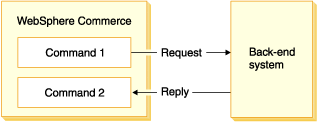Message classification
WebSphere Commerce supports four message interaction types:
WebSphere Commerce outbound notification
WebSphere Commerce sends a notification message to a back-end system, but does not expect an immediate response. The Report_NC_PurchaseOrder message is an example of this message type.
Back-end inbound notification
A back-end system sends a notification message to notify WebSphere Commerce of an event in the back-end system. The back-end system does not expect an immediate response from WebSphere Commerce. An example of this message type is the Report_NC_PurchaseOrder message.An inbound message is a request that WebSphere Commerce receives from an external application. Each inbound message activates a command in WebSphere Commerce that performs a particular function. If there is an error processing an inbound message, it is placed into the error queue.

WebSphere Commerce outbound request or reply
WebSphere Commerce sends a message to a back-end system and a response is expected from the back-end system. An example of this message type is the CheckAvailabilityBE message.This message type may be sent by using either of these mechanisms:
- The SendReceiveImmediate API. WebSphere Commerce sends a request to the back-end system and waits for a response. The command is blocked until a response has been received.

- WebSphere Commerce notification and back-end notification pairs. WebSphere Commerce sends a request and returns to the user, then the user requests WebSphere Commerce to check for the response. The back-end system receives the response request and sends notification to WebSphere Commerce. Finally, the request is processed and the database is updated.

Back-end inbound request or reply
A request to execute business logic is sent from a back-end system to WebSphere Commerce. The back-end system expect a response from WebSphere Commerce. An example of this message type is the Inquire_WCS_PickPackListDetail XML message.These messages can be activated by a request message in XML format, and some can be activated using the legacy message format. In general, the XML format is recommended. The XML messages are encoded in UTF-8 format.
The format of the XML messages consists of a set of XML elements defined within specific DTD files. Each DTD may contain one or more common files, identified by a .mod file extension. In addition, each inbound message is associated with a WebSphere Commerce controller command in the sys_template.xml message template definition file. All DTD, MOD, and XML files are located in the XML configuration directory in the messaging subdirectory.
Note: Some messages contain the letters NC in the name and others contain the name WCS in the name. Those with names that contain the letters NC are XML messages from previous versions of WebSphere Commerce. Those with WCS in the name use updated formats that offer greater flexibility. It is generally recommended that you use the WCS versions where you have choice.
(C) Copyright IBM Corporation 1996, 2006. All Rights Reserved.
